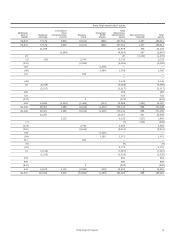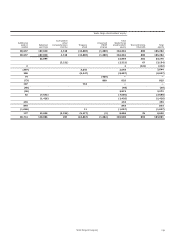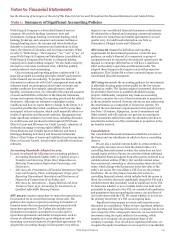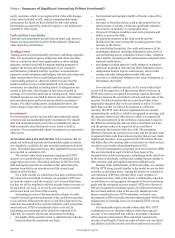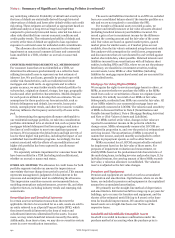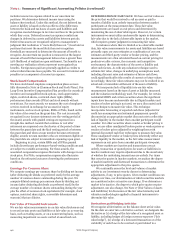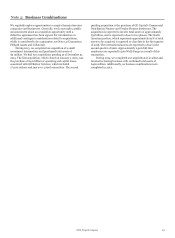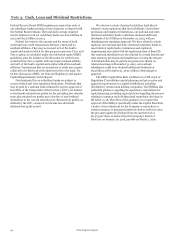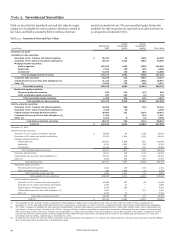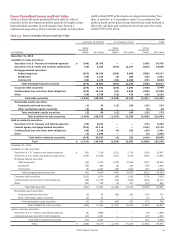Wells Fargo 2015 Annual Report Download - page 149
Download and view the complete annual report
Please find page 149 of the 2015 Wells Fargo annual report below. You can navigate through the pages in the report by either clicking on the pages listed below, or by using the keyword search tool below to find specific information within the annual report.higher than the fair value of net assets, including identifiable
intangible assets.
We assess goodwill for impairment at a reporting unit level
on an annual basis or more frequently in certain circumstances.
We have determined that our reporting units are one level below
the operating segments. At the time we acquire a business, we
allocate goodwill to applicable reporting units based on their
relative fair value, and if we have a significant business
reorganization, we may reallocate the goodwill. We have the
option of performing a qualitative assessment of goodwill. We
may also elect to bypass the qualitative test and proceed directly
to a quantitative test.
If we perform a qualitative assessment of goodwill to test for
impairment and conclude it is more likely than not that a
reporting unit’s fair value is greater than its carrying amount,
quantitative tests are not required. However, if we determine it
is more likely than not that a reporting unit’s fair value is less
than its carrying amount, then we complete a quantitative
assessment to determine if there is goodwill impairment. We
apply various quantitative valuation methodologies, including
discounted cash flow and earnings multiple approaches, to
determine the estimated fair value, which is compared to the
carrying value of each reporting unit. If the fair value is less than
the carrying amount, an additional test is required to measure
the amount of impairment. We recognize impairment losses as a
charge to noninterest expense (unless related to discontinued
operations) and an adjustment to the carrying value of the
goodwill asset. Subsequent reversals of goodwill impairment are
prohibited.
We amortize core deposit and other customer relationship
intangibles on an accelerated basis over useful lives not
exceeding 10 years. We review such intangibles for impairment
whenever events or changes in circumstances indicate that
their carrying amounts may not be recoverable. Impairment is
indicated if the sum of undiscounted estimated future net cash
flows is less than the carrying value of the asset. Impairment is
permanently recognized by writing down the asset to the
extent that the carrying value exceeds the estimated fair value.
Operating Lease Assets
Operating lease rental income for leased assets is recognized in
other income on a straight-line basis over the lease term. Related
depreciation expense is recorded on a straight-line basis over the
estimated useful life, considering the estimated residual value of
the leased asset. The useful life may be adjusted to the term of
the lease depending on our plans for the asset after the lease
term. On a periodic basis, leased assets are reviewed for
impairment. Impairment loss is recognized if the carrying
amount of leased assets exceeds fair value and is not recoverable.
The carrying amount of leased assets is not recoverable if it
exceeds the sum of the undiscounted cash flows expected to
result from the lease payments and the estimated residual value
upon the eventual disposition of the equipment.
Liability for Mortgage Loan Repurchase Losses
In connection with our sales and securitization of residential
mortgage loans to various parties, we establish a mortgage
repurchase liability, initially at fair value, related to various
representations and warranties that reflect management’s
estimate of losses for loans for which we could have a repurchase
obligation, whether or not we currently service those loans,
based on a combination of factors. Such factors include default
expectations, expected investor repurchase demands (influenced
by current and expected mortgage loan file requests and
mortgage insurance rescission notices, as well as estimated
levels of origination defects) and appeals success rates (where
the investor rescinds the demand based on a cure of the defect or
acknowledges that the loan satisfies the investor’s applicable
representations and warranties), reimbursement by
correspondent and other third-party originators, and projected
loss severity. We continually update our mortgage repurchase
liability estimate during the life of the loans.
The liability for mortgage loan repurchase losses is included
in other liabilities. For additional information on our repurchase
liability, see Note 9 (Mortgage Banking Activities).
Pension Accounting
We account for our defined benefit pension plans using an
actuarial model. Two principal assumptions in determining net
periodic pension cost are the discount rate and the expected
long-term rate of return on plan assets.
A discount rate is used to estimate the present value of our
future pension benefit obligations. We use a consistent
methodology to determine the discount rate based upon the
yields on multiple portfolios of bonds with maturity dates that
closely match the estimated timing and amounts of the expected
benefit payments for our plans. Such portfolios are derived from
a broad-based universe of high quality corporate bonds as of the
measurement date.
Our determination of the reasonableness of our expected
long-term rate of return on plan assets is highly quantitative by
nature. We evaluate the current asset allocations and expected
returns under two sets of conditions: (1) projected returns using
several forward-looking capital market assumptions, and (2)
historical returns for the main asset classes dating back to 1970
or the earliest period for which historical data was readily
available for the asset classes included. Using long-term
historical data allows us to capture multiple economic
environments, which we believe is relevant when using historical
returns. We place greater emphasis on the forward-looking
return and risk assumptions than on historical results. We use
the resulting projections to derive a base line expected rate of
return and risk level for the Cash Balance Plan’s prescribed asset
mix. We evaluate the portfolio based on: (1) the established
target asset allocations over short term (one-year) and longer
term (ten-year) investment horizons, and (2) the range of
potential outcomes over these horizons within specific standard
deviations. We perform the above analyses to assess the
reasonableness of our expected long-term rate of return on plan
assets. We consider the expected rate of return to be a long-term
average view of expected returns. The use of an expected long-
term rate of return on plan assets may cause us to recognize
pension income returns that are greater or less than the actual
returns of plan assets in any given year. Differences between
expected and actual returns in each year, if any, are included in
our net actuarial gain or loss amount, which is recognized in
OCI. We generally amortize net actuarial gain or loss in excess of
a 5% corridor from accumulated OCI into net periodic pension
cost over the estimated average remaining participation period,
which at December 31, 2015, is 20 years. See Note 20 (Employee
Benefits and Other Expenses) for additional information on our
pension accounting.
Income Taxes
We file consolidated and separate company federal income tax
returns, foreign tax returns and various combined and separate
company state tax returns.
We evaluate two components of income tax expense:
current and deferred. Current income tax expense represents our
estimated taxes to be paid or refunded for the current period and
Wells Fargo & Company
147


